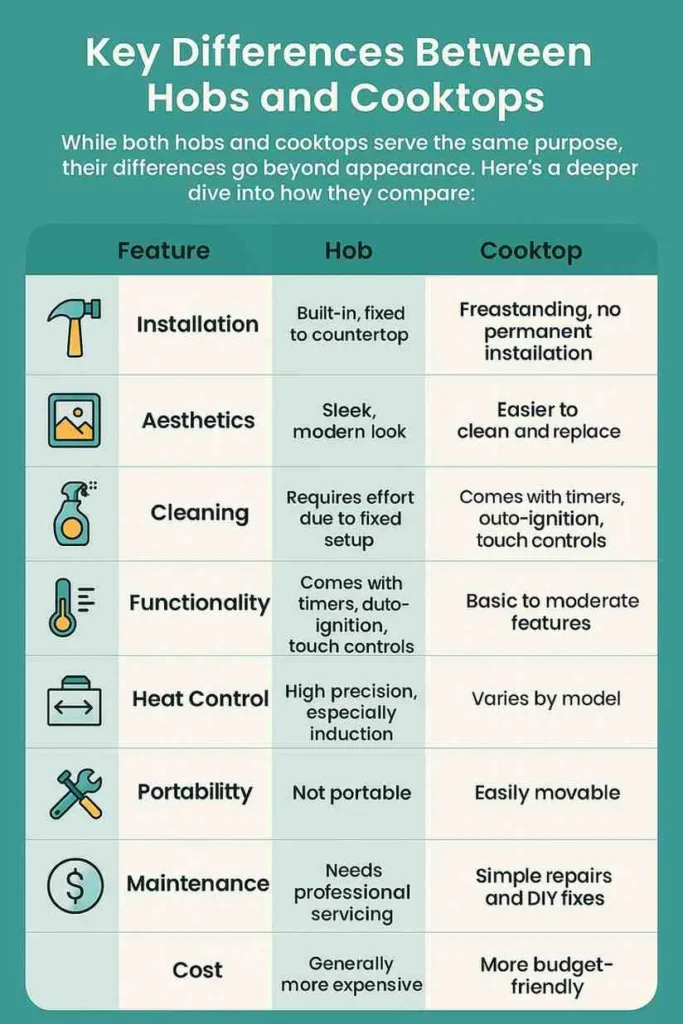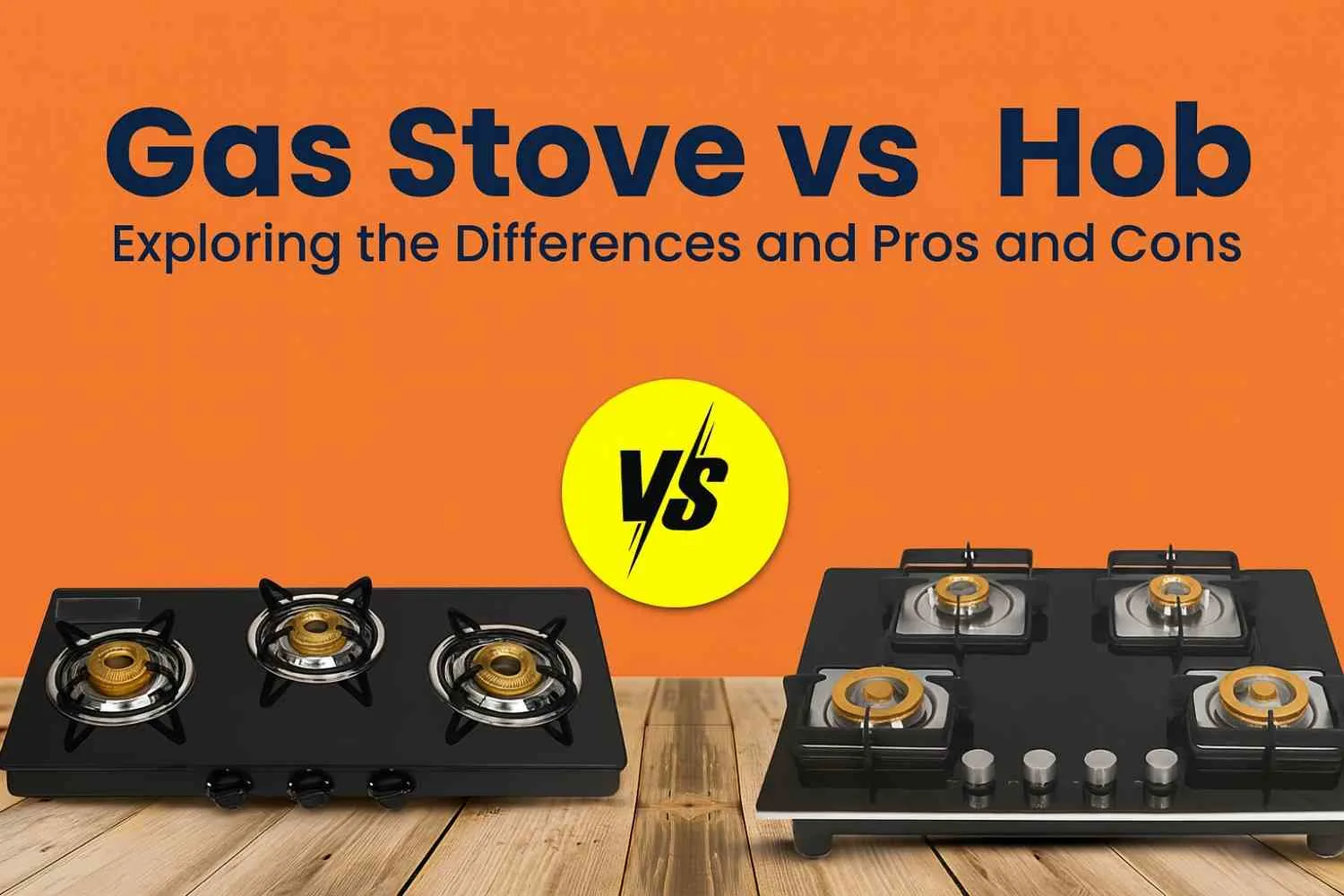Hobs vs. Cooktops – A Detailed Comparison Leave a comment
Choosing the right cooking appliance can significantly impact modern kitchens. Whether you’re remodelling your kitchen or just upgrading your stove, understanding your options is crucial. Among the most common choices are hobs and cooktops. These two serve the same purpose, helping you cook your meals, but they differ in design, functionality, and installation.
Choosing between hobs vs. cooktops isn’t just about aesthetics; it’s about matching the appliance to your lifestyle and kitchen setup. Do you prefer something sleek and seamless, or do you need something portable and budget-friendly? Each has its advantages depending on your needs, space, and cooking habits.
This guide aims to provide a detailed comparison between hobs and cooktops. From their features and functionality to pros, cons, and best use cases, we’ll walk you through everything you need to know. Whether you’re looking to upgrade your current setup or are furnishing a brand-new kitchen, this breakdown will help you make a confident choice.
What is a Hob?
A hob is a built-in cooking appliance that’s designed to blend seamlessly with your kitchen countertop. Unlike traditional stoves that stand alone, hobs are installed directly into the counter, offering a smooth and modern finish. Their popularity has soared in recent years, especially among homeowners investing in modular kitchens.
There are several types of hobs available:
- Built-in Gas Hobs: These operate on LPG or piped gas and usually come with multiple burners.
- Electric Hobs: Use electric coils or heating elements.
- Induction Hobs: These use electromagnetic fields to heat pots directly, providing precise and quick cooking.
Common features in a Hob include:
- Auto-ignition
- Flame failure safety devices
- Touch controls and timers
- Multiple heat settings
Hobs scores high in aesthetics and efficiency. They typically look more high-end and come with advanced safety features, making them a top choice for modern households. However, since they are fixed into the countertop, installation requires professional help and precise measurements. Maintenance can also be more demanding than freestanding units.
Explore our full range of Hobs to find one that fits your kitchen perfectly.
What is a Cooktop?
A cooktop, often referred to as a traditional stove, is a freestanding or portable cooking unit. Unlike hobs, cooktops are not integrated into the kitchen counter. This makes them more flexible and easier to install or move.
Cooktops come in various types:
- Freestanding Gas Stoves: These are the most common in Indian households. They usually come with 2 to 4 burners and sit atop the kitchen counter.
- Portable Electric Cooktops: Ideal for small kitchens or temporary setups, these use electric coils or induction technology.
- Tabletop Induction Cooktops: Lightweight and compact, great for minimal cooking needs.
Key advantages of cooktops include:
- Easy installation – just place and plug.
- Portability – can be shifted or replaced without hassle.
- Cost-effective – generally more affordable than hobs.
Cooktops are perfect for renters or anyone needing a quick, simple solution. Their straightforward design and basic features make them accessible and user-friendly. However, they tend to lack the sleek design and advanced features of hobs.
Check out our selection of Cooktops to find the right model for your kitchen.
Key Differences Between Hobs and Cooktops

While both hobs and cooktops serve the same purpose, their differences go beyond appearance. Here’s a deeper dive into how they compare:
| Feature | Hob | Cooktop |
| Installation | Built-in, fixed to the countertop | Freestanding, no permanent installation |
| Aesthetics | Sleek, modern look | More traditional design |
| Cleaning | Requires effort due to fixed setup | Easier to clean and replace |
| Functionality | Comes with timers, auto-ignition, touch controls | Basic to moderate features |
| Heat Control | High precision, especially induction | Varies by mode |
| Portability | Not portable | Easily movable |
| Maintenance cost | Needs professional servicing | Simple repairs and DIY fixes |
| Cost | Generally more expensive | More budget-friendly |
The differences become even clearer when considering kitchen layout and usage. If you’re designing a modular kitchen and want advanced features, a hob makes more sense. But if you’re prioritising budget and flexibility, a cooktop is your go-to.
Pros and Cons of Hobs and Cooktops
Pros of Hobs
- Seamless integration with modern kitchen decor.
- Equipped with advanced features like touch control, digital timers, and flame failure safety.
- Higher precision in heat control, especially with induction models.
- Ideal for heavy-duty and frequent cooking routines.
Cons of Hobs
- Requires professional installation, often increasing setup costs.
- Fixed in one location; can’t be moved easily.
- Repair and maintenance might need expert assistance.
Pros of Cooktops
- Budget-friendly and widely available.
- Easy to move, making them perfect for rented homes.
- Installation is straightforward—just place and plug in.
- A simple design means repairs and replacements are usually hassle-free.
Cons of Cooktops
- Takes up more space on the kitchen counter.
- Lacks the premium look of modern hobs.
- Fewer safety and tech features compared to Hobs.
When comparing hobs vs. cooktops, these pros and cons highlight why your lifestyle and kitchen structure should guide your decision. If you cook a lot and want your kitchen to have a sleek, integrated feel, hobs offer more functionality. But if you’re watching your wallet or need something portable, cooktops are incredibly practical.
Which One Should You Choose: Cooktops or Hobs?
Choosing between a hob and a cooktop depends on your specific needs and preferences. Here are a few pointers to guide your decision:
- Lifestyle and Cooking Habits: If you cook frequently and enjoy preparing meals that require multiple burners, a hob – especially one with four or more burners – can make your life easier. For light or occasional cooking, a basic cooktop might be more than enough.
- Kitchen Layout: Hobs blend beautifully with modular kitchen designs. They offer a smooth finish that looks custom-made. Cooktops, however, are better for kitchens with limited counter space or temporary setups.
- Budget: If cost is a concern, cooktops win hands down. They’re not only cheaper to buy but also easier and less expensive to maintain. Hobs, while more stylish and tech-savvy, come at a higher price tag and require professional help for installation and servicing.
- Space and Portability: In compact kitchens or rented spaces, cooktops offer greater flexibility. You can move or replace them anytime without damaging the kitchen structure. Hobs, being fixed, are more suited to permanent homes or custom kitchen installations.
Consider what matters most – style, function, price, or convenience. Both hobs and cooktops serve their purpose well. The right choice is the one that aligns best with your kitchen routine and living conditions.
Hob vs. Cooktop: Use Case Scenarios
To help you better visualize the ideal fit for your kitchen setup, here are a few real-life scenarios where either a hob or cooktop may be more suitable:
1. Modern Modular Kitchens:
If your kitchen is designed with a modular layout, hobs are a better choice. They offer a sleek, built-in aesthetic that aligns with cabinetry and countertops. Their seamless look elevates the overall design.
2. Rented Homes or Temporary Spaces:
A freestanding cooktop is ideal for rented apartments or temporary kitchen setups. Since cooktops don’t require permanent installation, they can be relocated easily without damage.
3. Heavy-Duty Cooking:
For families that cook large meals regularly or prefer multi-course dishes, hobs with multiple burners provide better performance. Especially induction hobs that allow for rapid heating and precise control.
4. Compact or Minimalist Kitchens:
If you’re working with limited space, a portable cooktop saves room and still offers solid performance. It’s a practical choice for single individuals, small families, or people who don’t cook often.
5. Budget-Conscious Buyers:
Cooktops are generally more economical upfront. They suit individuals or families who need functionality without splurging on premium design or tech features.
These examples highlight how different kitchen environments and cooking needs make either a hob or a cooktop the smarter choice.
Conclusion
After weighing all the differences between hobs vs. cooktops, it becomes clear that the best appliance for you depends on your kitchen layout, cooking style, and budget.
Hobs bring a modern, built-in look packed with safety and advanced features. They’re perfect for those seeking sophistication and precision in their cooking. But they do require a bit more planning and investment.
On the other hand, cooktops are flexible, affordable, and practical. They cater well to people with simpler setups, renters, or anyone who values convenience over aesthetics.
Before making your purchase, assess your needs, compare features, and decide which option aligns with your kitchen habits. Whether you go for a hob or a cooktop, the goal is to make cooking more enjoyable and efficient.
Still unsure? Explore our full range of Hobs and Cooktops to compare models and features.
FAQs
What is the main difference between a hob and a cooktop?
The primary difference lies in their installation and design. Hobs are built into the kitchen counter, offering a sleek and modern look, while cooktops are freestanding and portable. Hobs usually have more advanced features and require professional installation, whereas cooktops are easy to set up and move.
Which is better for Indian cooking – hob or cooktop?
Both can handle Indian cooking well, but hobs, especially gas hobs, offer better heat control and multiple burners for simultaneous cooking. This makes them ideal for preparing elaborate meals. Cooktops still work great and are easier to manage in smaller kitchens.
Are hobs more expensive than cooktops?
Yes, hobs are generally more expensive due to their integrated design and advanced features. They also incur additional installation costs. Cooktops are more budget-friendly and ideal for cost-conscious buyers.
Can I replace my cooktop with a built-in hob?
Yes, you can replace a cooktop with a hob, but it involves modifying your countertop to fit the hob. It’s best to consult a professional to ensure proper fitting and gas or electric connection.
Do hobs require professional installation?
Absolutely. Hobs must be installed by a qualified technician to ensure safe fitting and proper function, especially if they’re connected to a gas line or electric source.
Which is easier to clean – hob or cooktop?
Cooktops are easier to clean due to their standalone design. Hobs, being built-in, require a bit more effort to reach corners and under the surface, though many come with easy-to-clean materials.
Is a hob safer than a traditional cooktop?
Yes, hobs generally include safety features like flame failure devices, auto shut-off, and child locks – especially in induction models. Cooktops might lack these unless you’re opting for premium models.
Can I use an induction hob instead of a gas cooktop?
Definitely. Induction hobs are highly efficient and offer precise temperature control. Just ensure you have compatible cookware and a suitable power supply.
What are the pros and cons of using a hob in a modular kitchen?
Pros: Sleek design, advanced features, blends with modular kitchen aesthetics. Cons: Higher cost, needs professional installation, fixed in place.
Which is more energy-efficient – hob or cooktop?
Induction hobs are the most energy-efficient. Traditional gas cooktops or electric coil cooktops consume more energy in comparison.

